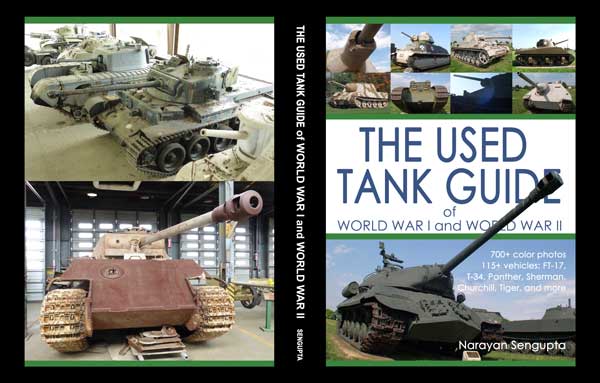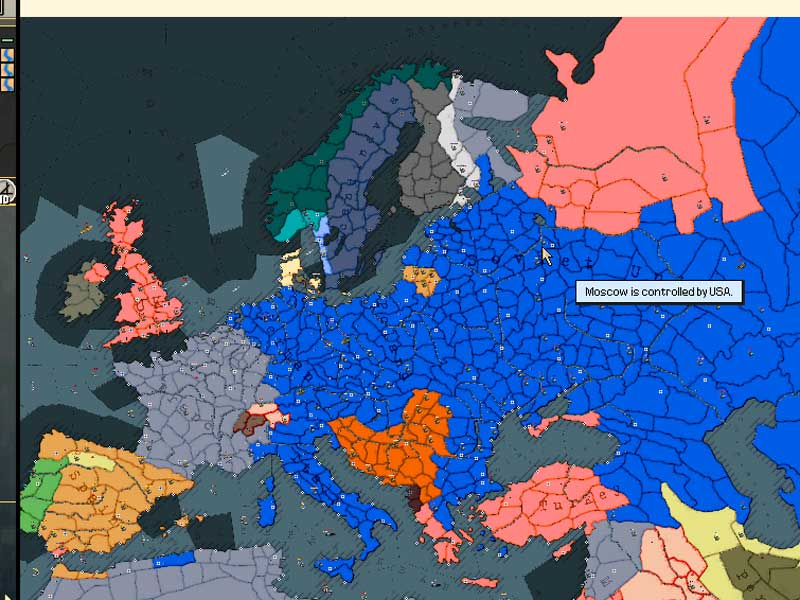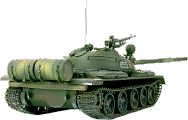by Philip Nelson
Operational Planning in PG3-SE: Part One
Winning a scenario in PG3-SE is done by achieving a goal of some kind. Operational planning in PG3-SE is done prior to
actually starting the scenario, and its purpose is to make completing the objectives of a scenario as easy as possible.
There are three kinds of objectives in PG3-SE: the capturing of hexes, the killing of enemy units, and the exiting off the
map of a certain number of your own units. Each kind can be used singly or be combined with others to form the overall
goal of a scenario. (There is one exception: I have never seen a scenario in which the only objective was the destruction of
enemy units.) Also, there can be secondary and tertiary objectives which are not required to be completed for the scenario
to be won. These are always hexes to be captured.
Hexes that must be captured, usually cities at key locations, are known as primary objectives. They are shown on the
strategic map as diamonds with a gold border. Secondary objectives are shown as diamonds with silver borders; airfields
are shown as triangles; and tertiary objectives are shown as circles. All can be captured, giving you points for doing so; but
you lose points if the enemy captures them. Sometimes you can receive bonuses for capturing them; but, for the most part,
that only occurs at primary and secondary objectives.
Both the scenario goal and the strategic map can be viewed before you build your army for a scenario, allowing you to
precisely plan a course of action and tailor your army to that plan. In a scenario involving only the capturing of objectives,
first scan the map for the primary objectives and for your deployment zones, noting their locations relative to each other;
and then check the road access to the various objectives. Note the locations of airfields and other objectives as well. You
should now have the data to answer these crucial questions, keeping in mind the state of your equipment pool and leader
pool:
Can one task force be reasonably expected to capture every primary objective within the time allotted? If not, how many
are necessary? Is there road access to all primary objectives? Are there secondary objectives near the routes to primary
objectives? Are any remote secondaries worth targeting? Should the capturing of an airfield be a high priority? Are the
primary objectives isolated cities, or are there other city hexes surrounding them? Is there a need to defend any primary
objectives already controlled?
Correctly answering these questions is extremely important in developing a successful plan for such a scenario.
Note that there are two kinds of task forces- one to capture objectives without road
access, and one to capture those with road access. The first should only have
self-propelled artillery, and the second should mostly have towed artillery. That is the
most important difference between the two task forces. All engineers and armor have
cross-country ability, and most recons have that as well. However, some recons do not-
notably the PSW 222 and the Soviet BA series(excepting the BA-64). Also, Soviet
air-defense units with cross-country ability are very rare, though German ones are
common.
Also note that checking the hexes around objectives allows you to determine whether they are large cities. If so, they will
probably have heavy defenses.
The best-laid plans can, of course, go awry; but often they help you quickly win tough scenarios.
Operational Planning in PG3-SE: Part Two
In the last article we discussed the basics of planning for a scenario in which only hexes
needed to be captured. In this article we will have a look at that kind of operational
planning in action.
Let's take the first southern scenario in Guderian. Examining the strategic map, we find that there are only two primary
objectives- both with adjacent city hexes. The deployment area is in the southwest, and there will be three rivers to cross in
order to reach the more distant objective. There is adequate road access to the first objective; but while there is a road to
the second, it detours considerably and will probably slow down an advance too much to be useful. Still, only one
battle-group should be necessary- both objectives can be easily reached with one spearhead from the deployment area, and
there is a readily accessible airfield by the first. There is one primary objective to be held throughout the scenario.
Now we need to build a task force around the information we have gathered. Because there are rivers to be crossed, Pionere
should be chosen over Strosstruppen for their bridging ability. There is no self-propelled artillery available; therefore the
final objective will have to be taken without artillery support. A bomber is thus necessary; and a fighter will be
requisitioned to protect the bomber. There is a high-quality Pz IV tank available; but it is at low strength, and only has a
movement of four. On the other hand, the Pz IB is an excellent choice both for its strength and speed. Towed artillery will
be used to help capture the first objective. Because slots are valuable, headquarters will be left undefended; and that
should not be a problem as long as all offensive Polish units are destroyed.
Because the towed artillery cannot possibly reach the final objective in time to do much good, we can use it elsewhere.
There is a secondary objective to the north with adequate road access; and once the first primary has fallen, the artillery
will be diverted there with one other ground unit - perhaps a Strosstruppen or an extra tank.
A recon, the Pionere, and the Pz IB can quickly cross the open terrain between the two primary objectives, and they
shouldn't have a problem capturing the final objective as long as they have adequate air support. There is also a secondary
near the final objective, and it should prove to be easy to capture.
This plan should allow us to quickly win the scenario if all goes well; and provide a flexible base for alternatives if it
doesn't.
Now for a more high-octane example. The Leningrad scenario from the Guderian campaign is one of the toughest in the
game. The deployment area is once again in the southwest. There is an isolated primary objective in the northeast. Though
it shouldn't be heavily defended, it has little road access; and any task force heading that way must cross several rivers.
Leningrad itself is in the far north, and includes the rest of the primary objectives. There are many city hexes; and it is
obvious that it will be one of the most heavily-defended areas in the game. Fortunately, there is a good road leading to
Leningrad from our deployment area. But there are no convenient airfields; the closest is on the outskirts of Leningrad.
There is a primary to be defended in the southwest.
Two task forces will be necessary- a light cross-country battle-group, and the heaviest possible battle-group for Leningrad.
A good air-force will be necessary as well. Since every slot is vital, headquarters will not be garrisoned.
The cross-country task force will probably have plenty of time to complete its main objective, since the assault on
Leningrad should take quite a while. There are two secondaries or so near the isolated primary, and the light task force
could concentrate on capturing those. However, if things are not going well at Leningrad, it could instead be diverted there
in order to aid in fighting that battle.
This plan should give us a good chance at winning the scenario in time for a major, though much depends upon the
street-fighting in Leningrad.
Operational Planning in PG3-SE: Part Three
In this article we will have a look at planning for the unique challenges posed by the two
other types of objectives- exiting ground units and destroying enemy units.
Planning for a scenario in which the only objective is to exit a certain number of ground units is rather straightforward.
Simply look for your deployment area and the exit hexes. Regardless of the number of exit hexes, check the road access to
them and the location of secondary objectives. Secondaries are often well-defended in these types of scenarios.
If you must stay on roads, the path you choose depends on how quickly you can reach the exit hexes using it, and on how
much of a fight you want. Secondaries can be good to capture, but doing so can slow you down significantly if the enemy
defenses are strong. Conversely, you could deploy only all-terrain units and simply maneuver around enemy defenses,
striking secondaries at will. That is sometimes the best method for winning these scenarios. Also, using more than one
battle-group can be good on occasion.
Remember, check the number of units required to exit in order to win, and make certain you have enough in your main
battle-group to do so throughout the scenario. It is all too easy to have a few units sidetracked by isolated enemy forces and
secondaries.
Planning for scenarios in which the objectives include a number of enemies to destroy is rather difficult. Unless you have
played the scenario before, there is usually no way of knowing where the targeted enemies will be. To counter that, deploy
a force heavy in fighters, recons, and bombers. With them, you can scout the entire map. It is difficult to kill enemy units
outright with bombers; but they can force enemies to refit, pinning them until your ground forces are able to deal with
them. Note that sometimes targeted units are not deployed on the first turn, but instead appear as reinforcements later in
the scenario- making good scouting even more imperative.
Many scenarios have objectives that include two of the three kinds, and there are some with all three. Planning for those
can be very difficult; however, combining the planning phases of all types represented in a scenario is usually successful.
Operational Planning in PG3-SE: Part Four
In this article we will complete our examination of operational planning in PG3-SE by
taking a look at it in action in a scenario with all three objective types- Voronezh Vendetta
from the Guderian campaign. The following includes a short after-action report I wrote for
that scenario.
Going into the scenario, I had two Blitz tanks, six artillery pieces(two self-propelled), two recons, three air defense units,
three Tactician infantry units, two fighters, and four bombers. The main deployment area is in the west-central area; and a
smaller deployment area is in the northwest. I had one primary to defend(headquarters), and one located in the southeast
to capture. The lone exit hex was located not far to the east of that primary. There was a secondary objective in both the
northwest and southwest areas, and a couple of them in the northeast.
My objectives were to capture Lypove, destroy the nine targeted units, and exit ten units. After examining the map, it
became obvious that I needed to send a large battle-group southeast to capture Lypove, because the exit hex was so near to
it. Now, there is a major river that runs past Lypove to the north, and it continues on to flow a little south of my main
deployment area. There are also smaller rivers in the north and a swamp in both the northern and eastern regions; and
together, they all form a kind of circle around a large region of open terrain in the center of the map. Since there is nothing
but roads in that area, I decided to bypass it by sending my main task force consisting of nine units south to capture the
secondary there, and then east to capture to Lypove and exit.
I used only nine units in that battle-group because I wanted to deploy a northern cross-country task-force, consisting of a
tank, two artillery pieces(one self-propelled), an AD unit, a recon, and an infantry unit- six units in all. Their orders were
to advance along the northern edge of the map, capturing as many secondaries as possible while remaining on alert for the
targeted units.
Because I was bypassing the wide-open central region, I left an infantry unit to defend headquarters, with orders to
advance southeast mid-battle and eventually exit as the tenth unit.
That was the plan. It wasn't too good in regards to exiting the ten units; but because of the nine targeted units, I wanted the
flexibility two good battle-groups and a large, competent air-force gave me. And here's the result:
"Not a bad scenario, but the diverse victory conditions made it difficult to follow a cohesive battle plan. I deployed ten
ground units in the south, and the rest in the north.
Nine of those in the south advanced into the deep south, capturing the secondary. They then proceeded to Lypove, where
they slaughtered the Soviet defenses. I left the Strosstruppen behind to guard headquarters. Later, I advanced that unit
southeast, where it was instrumental in destroying some of the targeted units.
My northern forces advanced east slowly, battling fragmentation because of the tempting, though widespread, array of
vulnerable enemy units. Most of them rejoined in time to fight the bulk of the targeted units, which were mainly heavy
armor. That was a bitter battle, but bomber strikes carried the day. The recon from this battlegroup streaked southeast in
time to exit ten units for the major.
My nine units in the south had not been idle, as the AI deployed swarms of reinforcements directly south of Lypove. I was
not able to contain all of them; and they recaptured several cities and airfields, costing me points."
As you can see, my plan did not survive the actual battle. The Strosstruppen had to be diverted to attacking the targeted
units, as they were directly in its path southeast. The nine units in the south were idle for a long time- a waste of resources,
though they did destroy quite a few enemy reinforcements. Because of my poor planning in regards to exiting, I had to
scramble for the tenth unit at the end of the scenario, nearly costing me the major victory.
In hindsight, I should have sent the smaller task force south, and the larger battle-group in two mutually-supporting task
forces east through the center region. That would have given me a chance to capture all secondaries, while ensuring that I
had enough units to exit. I would not have needed to garrison headquarters, giving me another front-line unit; and I still
would have had enough flexibility to take on the targeted units when they arrived.
Philip Nelson

Wargame Patches, Scenarios...
Books & more...

Tanks! - 90 pages of tank photos

USAF, USN and Tank Screen Savers
Hearts of Iron II
People's General
Panzer General
Allied General/Cold War General
Pacific General
Strategic Command 2
Commander - Europe at War

American Eagles - The Illustrated
History of American Aviation
in World War I $9.95
Lafayette Escadrille: America's Most Famous Squadron $9.95

Battleship Bismarck
Disaster at Dieppe!
Robert Thibault, French Soldier
Liberation of France in 1944

Paris fortifications
Verdun (7 pages)
 French Military Victories...
French Military Victories...Design Credit:
Website: Atlanta SEO

 Home
Home Hearts of Iron
Hearts of Iron


